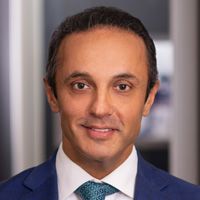How Risk Profiling Can Help Score a More Secure Retirement
Based on the work of a Nobel laureate, determining your personal risk number can help pinpoint a sweet spot for the level of risk that's appropriate for your investment portfolio.


Your portfolio should reflect your risk tolerance.
How many times have you heard this tidbit of advice and wondered if you were overexposed, underexposed or exactly where you should be when it comes to investment risk?
Certainly, it makes sense that your investments should match your ability (financially) and willingness (emotionally) to stomach large swings in the market. But how are you supposed to know what your personal risk tolerance is? Unless you’ve experienced an extreme high or low as an investor, it’s hard to know how you’ll react. Even those who were hurt badly in 2000 and 2008 are finding it difficult to control the greed or fear that current market conditions can evoke.
From just $107.88 $24.99 for Kiplinger Personal Finance
Become a smarter, better informed investor. Subscribe from just $107.88 $24.99, plus get up to 4 Special Issues

Sign up for Kiplinger’s Free Newsletters
Profit and prosper with the best of expert advice on investing, taxes, retirement, personal finance and more - straight to your e-mail.
Profit and prosper with the best of expert advice - straight to your e-mail.
Labeling Yourself as ‘Conservative’ Just Doesn’t Cut It
For those nearing retirement, there’s the general guideline that you should have less risk as you get closer to needing your nest egg. But that, too, is an awfully broad concept. And we’ve learned that popular terms like “conservative,” “moderate” and “aggressive” can be misleading. (A 60-year-old’s idea of moderate investing, for example, may be far different than a 35-year-old’s perspective.)
The good news is that investors now can better define their individual risk tolerance through a process that assigns them a “risk number” instead of a subjective term or an estimate based on a brief conversation. The process starts with an in-depth questionnaire that helps determine how much investment risk a person is comfortable with taking in order to obtain a potentially larger financial reward. And it’s based on decades of work in behavior economics, including “prospect theory,” which earned American psychologist and economist Daniel Kahneman the Nobel Memorial Prize in Economics in 2002.
Find Out What Your Risk Number Is Instead
What is a risk-number profile? A risk-number profile typically looks at the level of risk an individual can afford to take, the risk he or she prefers to take, and the amount of risk that might be required to achieve the person’s goals. The process used to determine your risk-number spots patterns in the answers and assigns a risk number somewhere on a scale from zero to 100. That number can then be used to determine whether the investor’s current portfolio is a match, how it would stand up under various market conditions, and what, if anything, should be changed to make it a better fit.
Just as significantly, it can help informed investors set realistic expectations and stay on track as they move forward.
Probably the most important thing about knowing your risk number is that it can help you stop piecemealing your portfolio. Too frequently, people pick up investments from year to year — stocks, bonds, annuities, CDs or whatever — without any plan in place. Maybe a friend told them about a killer stock, so they bought in. Then they read that exchange-traded funds (ETFs) were the best way to go, and they added those. They also signed up for the 401(k) at work without really knowing what’s in their plan, other than that they chose a 60/40 or 50/50 mix.
The problem is, that piecemeal approach can end up costing more in the long run than hiring a financial professional to get a comprehensive plan — one that actually suits your needs, objectively aligns with your specific goals and evolves with you.
Because this isn’t like Ron Popeil’s rotisserie oven: There’s no such thing as “set it and forget it” in financial planning. As your life changes, your investment strategies likely will have to change with it — especially as you reach retirement. Unfortunately, that’s often when people suddenly start paying closer attention to how their investments are performing, how much they’ve accumulated in their nest egg and whether it’s enough to get them through 20 to 30 years or more.
They get nervous. And that can lead to mistakes.
Risk Profiles Help During the ‘Retirement Red Zone’
Building a solid foundation can help you stick to what’s working and change what isn’t when it makes sense based on life events, instead of panicking during market dips and downturns. That’s especially critical in the five or so years leading up to retirement and the first five years into retirement — usually referred to as the “retirement red zone.” Taking a hit to your nest egg during this period, without time to recover the money, can be devastating.
The cost of living keeps increasing. So does the average life expectancy. It’s critical to have a plan that will keep providing income as long as you and your spouse need it.
That’s why I recommend working with a seasoned adviser (a fiduciary who’s looking out for your best interests) to obtain your risk profile, review it and help create a plan based on that knowledge — not a cookie-cutter portfolio that’s the same as every guy or gal who ever sat next to you at work. The information and insight a risk profile provides can help you protect your financial future.
Kim Franke-Folstad contributed to this article.
The appearances in Kiplinger were obtained through a PR program. The columnist received assistance from a public relations firm in preparing this piece for submission to Kiplinger.com. Kiplinger was not compensated in any way.
Profit and prosper with the best of Kiplinger's advice on investing, taxes, retirement, personal finance and much more. Delivered daily. Enter your email in the box and click Sign Me Up.

Reid Abedeen is the managing partner at Safeguard Investment Advisory Group, LLC. As an investment adviser, he has been helping retirees with insurance, long-term care planning, financial services, asset protection and other issues for more than 20 years. Abedeen has a degree in business administration. He holds California Life-Only and Accident and Health licenses and a Series 65 license, and he is registered through the Financial Industry Regulatory Authority.
-
 Stocks Struggle Ahead of November Jobs Report: Stock Market Today
Stocks Struggle Ahead of November Jobs Report: Stock Market TodayOracle and Broadcom continued to fall, while market participants looked ahead to Tuesday's jobs report.
-
 7 Dr. Seuss Quotes Retirees Should Live By
7 Dr. Seuss Quotes Retirees Should Live ByYou're off to great places! Why Dr. Seuss is the retirement guru you didn't know you needed.
-
 Fed's Rate Cuts Could Have Impacts You Might Not Anticipate
Fed's Rate Cuts Could Have Impacts You Might Not AnticipateUnderstanding how lower interest rates could impact your wallet can help you determine the right financial moves to make.
-
 Past Performance Is Not Indicative of Your Financial Adviser's Expertise
Past Performance Is Not Indicative of Your Financial Adviser's ExpertiseMany people find a financial adviser by searching online or asking for referrals from friends or family. This can actually end up costing you big-time.
-
 I'm a Financial Planner: If You're Not Doing Roth Conversions, You Need to Read This
I'm a Financial Planner: If You're Not Doing Roth Conversions, You Need to Read ThisRoth conversions and other Roth strategies can be complex, but don't dismiss these tax planning tools outright. They could really work for you and your heirs.
-
 Could Traditional Retirement Expectations Be Killing Us? A Retirement Psychologist Makes the Case
Could Traditional Retirement Expectations Be Killing Us? A Retirement Psychologist Makes the CaseA retirement psychologist makes the case: A fulfilling retirement begins with a blueprint for living, rather than simply the accumulation of a large nest egg.
-
 I'm a Financial Adviser: This Is How You Can Adapt to Social Security Uncertainty
I'm a Financial Adviser: This Is How You Can Adapt to Social Security UncertaintyRather than letting the unknowns make you anxious, focus on building a flexible income strategy that can adapt to possible future Social Security changes.
-
 I'm a Financial Planner for Millionaires: Here's How to Give Your Kids Cash Gifts Without Triggering IRS Paperwork
I'm a Financial Planner for Millionaires: Here's How to Give Your Kids Cash Gifts Without Triggering IRS PaperworkMost people can gift large sums without paying tax or filing a return, especially by structuring gifts across two tax years or splitting gifts with a spouse.
-
 'Boomer Candy' Investments Might Seem Sweet, But They Can Have a Sour Aftertaste
'Boomer Candy' Investments Might Seem Sweet, But They Can Have a Sour AftertasteProducts such as index annuities, structured notes and buffered ETFs might seem appealing, but sometimes they can rob you of flexibility and trap your capital.
-
 Quick Question: Are You Planning for a 20-Year Retirement or a 30-Year Retirement?
Quick Question: Are You Planning for a 20-Year Retirement or a 30-Year Retirement?You probably should be planning for a much longer retirement than you are. To avoid running out of retirement savings, you really need to make a plan.
-
 Don't Get Caught by the Medicare Tax Torpedo: A Retirement Expert's Tips to Steer Clear
Don't Get Caught by the Medicare Tax Torpedo: A Retirement Expert's Tips to Steer ClearBetter beware, because if you go even $1 over an important income threshold, your Medicare premiums could rise exponentially due to IRMAA surcharges.